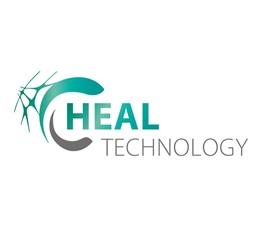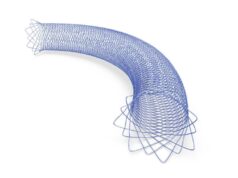This advertorial is sponsored by Acandis.
 While intracranial stents are among the devices most commonly used by neurointerventionists, one challenge that hampers their utilisation in routine practice is thrombogenicity. However, HEAL (Acandis)—a novel coating technology applied to the surface of these devices—has emerged as a means for improving overall treatment safety. Here, NeuroNews speaks to Tomáš Riedel (Czech Academy of Sciences, Prague, Czechia), a scientist who played a leading role in developing the technology, and Hannes Nordmeyer (Solingen Municipal Hospital, Solingen, Germany), a physician with firsthand experience using and studying HEAL, to discuss its potential.
While intracranial stents are among the devices most commonly used by neurointerventionists, one challenge that hampers their utilisation in routine practice is thrombogenicity. However, HEAL (Acandis)—a novel coating technology applied to the surface of these devices—has emerged as a means for improving overall treatment safety. Here, NeuroNews speaks to Tomáš Riedel (Czech Academy of Sciences, Prague, Czechia), a scientist who played a leading role in developing the technology, and Hannes Nordmeyer (Solingen Municipal Hospital, Solingen, Germany), a physician with firsthand experience using and studying HEAL, to discuss its potential.
HEAL is an innovative, non-eluting surface modification technology that consists of a fibrin mesh with bound heparin. This unique combination mimics the last step of haemostasis, leading to anti-thrombogenic, anti-inflammatory and endothelialisation-promoting properties, creating the potential to quickly occlude aneurysms and reduce complications associated with endovascular treatment.
“The HEAL coating is a groundbreaking technology designed specifically for neurovascular stents, incorporating several innovative features that enhance its performance and safety,” Riedel says. “It addresses the inherent challenges associated with stent implantation, such as the risk of thrombosis, inflammation, and delayed healing.”
A key characteristic of HEAL is its combination of two separate endogenous components: fibrin and heparin.
“The fibrin network is produced through a process that closely mimics the final stage of haemostasis, replicating the natural formation of fibrin during the wound healing process,” Riedel explains. “This biomimetic approach ensures that the fibrin has very low thrombogenicity, and provides an excellent scaffold for endothelial cells, thereby creating an environment conducive to vessel repair—which is critical for long-term stent success. And, to further reduce thrombogenicity of the coating, heparin is covalently crosslinked within the fibrin matrix. This ensures that the heparin remains firmly attached to the fibrin coating, making it stable and more resistant towards fibrinolysis while providing a localised effect without being released into the bloodstream. By immobilising heparin in this way, HEAL creates a strong anti-thrombogenic cover at the stent site, reducing the risk of thrombosis while avoiding the potential complications of systemic anticoagulation.
“In this way, fibrin and heparin work synergistically in the HEAL coating, with both components helping to reduce inflammation and create an environment that is crucial for restoring the integrity of the vessel lining.”
Standing out from the crowd
According to Riedel, HEAL has the capacity to provide a “highly effective and safe solution for neurovascular stenting”, with its effects having been confirmed via “extensive” in-vitro and in-vivo studies.1–3 Through its anti-thrombogenic, anti-inflammatory and endothelialisation-promoting characteristics, HEAL offers benefits that directly target “crucial” challenges associated with neurovascular stent placement. The technology’s anti-thrombogenicity eases a “major concern” associated with neurovascular procedures by reducing the risk of blood clot formation; its anti-inflammatory properties help minimise vessel wall inflammation, which can lead to complications like restenosis; and, by promoting growth of healthy endothelial cells over the stent, it can be seen to facilitate natural vessel healing and potentially reduce rates of long-term complications. Owing to these characteristics as well as its biomimetic design and non-eluting, localised action, Riedel believes that HEAL “sets itself apart” from other coatings.

“HEAL stands out because it directly covers all these critical aspects related to neurovascular stent treatment at once,” he states, adding that the majority of current surface modification technologies target either thrombogenicity or endothelialisation—but typically fail to address both simultaneously.
“HEAL provides a balanced solution by tackling both immediate and long-term challenges,” he notes. “Its combined, comprehensive approach offers significant advantages over other commercially available coatings, as well as mitigating the need for prolonged dual antiplatelet therapy [DAPT], which is a common requirement with stents. In fact, existing studies suggest HEAL can be effectively used under single antiplatelet therapy [SAPT], lowering risks of bleeding complications and enhancing the patient’s quality of life.”
The study Riedel cites here was published earlier this year by Uysal et al in the American Journal of Neuroradiology, detailing initial experiences treating brain aneurysms with the DERIVO® 2heal® Embolisation Device (Acandis) under standard or reduced-dose SAPT. The authors observed an absence of permanent, periprocedural neurologic deficits and favourable occlusion rates, indicating HEAL’s potential to increase the safety and efficacy of flow diversion.4
SAPT versus DAPT
“Nowadays, we’re facing more and more emergency situations that demand DAPT—for example, in rescue stenting or in aneurysm treatment,” Nordmeyer says. Regarding the former example, he highlights ischaemic stroke cases where recanalisation cannot be achieved via first-line thrombectomy, leading the operator to place a stent instead.
“These patients are not prepared for stenting, because they are usually not on DAPT beforehand,” he adds. “We need to put them on aggressive therapy and, in an emergency setting, we need fast-acting medications to keep the stent open.”
Such patients have likely undergone a complex recanalisation procedure that carries the risk of bleeding-related complications—a risk exacerbated by the medications required during rescue stenting. “What we need in these cases are products that could enable us to treat them under mono-prasugrel or mono-clopidogrel therapies,” Nordmeyer explains.
He goes on to state that a similar concept applies to haemorrhagic diseases, including acute aneurysm cases that cannot be successfully treated with coils or intrasaccular devices, thus requiring stent usage and creating “the same problem” of bleeding risks. As such, coated stents “would be a gamechanger in these situations”, according to Nordmeyer.
HEAL’s potential benefits recently moved closer to being more widely realised, as the DERIVO 2heal Embolisation Device’s instruction for use (IFU) has been updated to give physicians the choice of implanting the device alongside SAPT—when no other treatment option is deemed suitable and it is justified due to, for example, heightened risks of haemorrhagic complications.
Clinical experiences
Nordmeyer and his team in Solingen implanted their first HEAL-coated devices in 2021—and, today, their experiences with the coating comprise a large series of both ischaemic and haemorrhagic cases. Here, Nordmeyer highlights multiple instances of strokes and brain aneurysms in which HEAL has enabled his team to treat patients using devices like the DERIVO 2healEmbolisation Device, or the CREDO® heal Stent (Acandis), while also transitioning them to a monotherapy and ultimately making their antiplatelet strategy “less aggressive”.

A multicentre study published recently in Clinical Neuroradiology by Dorn, Nordmeyer et al constitutes the largest clinical evaluation of the CREDO heal Stent to date. In 81 patients receiving post-thrombectomy rescue stenting to treat intracranial stenosis, the device was found to be safe and effective, with final modified thrombolysis in cerebral infarction (mTICI) 2b–3 achieved at a rate of 95.1% after a median of two thrombectomy manoeuvres plus stenting, and just four periprocedural complications resulting in clinical deterioration being observed.5
However—similarly to Uysal et al—the authors conclude that more data are needed to define optimal antithrombotic regimes in these cases. Nordmeyer adds that sufficient antiplatelet therapy will likely remain “mandatory” in rescue stenting until further studies have established the real-world advantages of implanting the CREDO heal Stent under SAPT.
“Apart from HEAL’s reduced thrombogenicity that, of course, has to be proven in larger trials like RECHRUT, we have to evaluate the reduction of inflammatory reactions and endothelialisation,” he continues. “As per the literature, we expected a 15–20% rate of in-stent restenosis in these cases—but, in those evaluated with follow-up DSA [digital subtraction angiography], we found much lower in-stent restenosis numbers due to neointimal hyperplasia. This may be attributed to the reduced inflammatory effects and more natural endothelial healing enabled by HEAL.”
Alluded to here by Nordmeyer, RECHRUT is an ongoing study evaluating post-thrombectomy rescue stenting with the CREDO heal Stent. Recently presented interim results show “technical and clinical success in line with the literature on rescue stenting”, with a 100% rate of mTICI 2b–3 recanalisation and no recurrent occlusions in the first 18 patients enrolled.6
“I think the potential of such a coating is really significant, once we have data that give us the confidence to really change our antiplatelet regimens, because it opens the door to treat more patients— including in the acute setting, in patients with a high haemorrhagic risk who have to be treated under SAPT,” Nordmeyer concludes. “It could also enable us to apply these products to more processes inside smaller vessels where very subtle intimal hyperplasia can lead to severe and haemodynamically relevant in-stent restenosis. So, overall, HEAL could alleviate some of the biggest concerns around putting implants into the neurovasculature.”
References:
- Kaplan O, Hierlemann T, Krajewski S et al. Low-thrombogenic fibrin-heparin coating promotes in vitro endothelialization. J Biomed Mater Res A. 2017; 105(11): 2995–3005.
- Mühl-Benninghaus R, Fries F, Kießling M et al.Vascular response on a novel fibrin-based coated flow diverter. Cardiovasc Intervent Radiol. 2022; 45: 236–43.
- Girbas M G, Riedel T, Riedelová Z et al. Comparison of the hemocompatibility of neurovascular flow diverters with anti-thrombogenic coatings. J Sci Adv Mater Devices. 2024; 9: 100666.
- Uysal A, Cay F, Balcı S et al. Initial experience with the Derivo 2Heal flow diverter under standard or reduced-dose single antiplatelet therapy. Am J Neuroradiol. 2024; 45(8): 1038–43.
- Dorn, F, Voss Y L, Zidan M et al.A new fibrin-heparine coated self-expanding stent for the rescue treatment of intracranial stenosis—a multicentric study. Clin Neuroradiol. 2024. DOI: 10.1007/s00062-024-01448-6.
- Nordmeyer H. Rescue stenting with CREDO heal for recanalisation after unsuccessful thrombectomy (RECHRUT)—interim results. J Neurointerv Surg. 2024; 16: A98.










